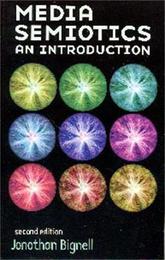
|
Media Semiotics: An Introduction
Paperback / softback
Main Details
| Title |
Media Semiotics: An Introduction
|
| Authors and Contributors |
By (author) Jonathan Bignell
|
| Physical Properties |
| Format:Paperback / softback | | Pages:256 | | Dimensions(mm): Height 216,Width 138 |
|
| ISBN/Barcode |
9780719062056
|
| Classifications | Dewey:302.23014 |
|---|
| Audience | | Tertiary Education (US: College) | | General | | Professional & Vocational | |
|---|
| Edition |
2nd edition
|
| Illustrations |
Illustrations, black & white
|
|
Publishing Details |
| Publisher |
Manchester University Press
|
| Imprint |
Manchester University Press
|
| Publication Date |
4 April 2002 |
| Publication Country |
United Kingdom
|
Description
This is an expanded and revised edition of an investigation of the critical approach in contemporary media studies. The main media studied on university courses (advertising, magazines, the press, TV, cinema, "new media" including computer games, the Internet and the World Wide ) are all addressed substantially and in separate detailed chapters. New material in this second edition includes sections on men's style magazines, docusoaps and "reality TV", digital interactive television, and mobile phone text messaging. It begins by explaining the concept of the sign and the ideological roles of media in contemporary culture and then scrutinises advertisements, glossy magazines, daily newspapers, TV programmes, recent films, and interactive media, with each chapter containing close analyses of particular examples. Key strands in critical theory such as ideology and psychanalytic theory are explored and challenges to established semiotic methods posed by audience studies and postmodernism are discussed.
Author Biography
Jonathan Bignell is Senior Lecturer in Media Arts at Royal Holloway, University of London -- .
ReviewsJonathan Bignell's comprehensive, intelligent and readable introduction to semiotics is ahead of the field in clarity, in its astutue use of contemporary examples, and in his openness to both the latest theoretical developments and the criticisms of semiotics theory launched over the last decade by media sociologists.|...best suited to upper-level undergraduates and keen graduate students in media/cultural studies, providing an accessible and lucid overview of things they should really know about. -- .
|